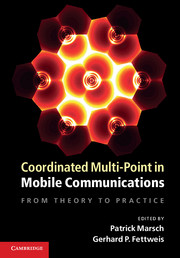Book contents
- Frontmatter
- Contents
- List of Contributors
- Acknowledgements
- List of Abbreviations
- Nomenclature and Notation
- Part I Motivation and Basics
- Part II Practical CoMP Schemes
- 5 CoMP Schemes Based on Interf.-Aware Transceivers or Interf. Coord.
- 6 CoMP Schemes Based on Multi-Cell Joint Signal Processing
- Part III Challenges Connected to CoMP
- Part IV Performance Assessment
- Part V Outlook and Conclusions
- References
- Index
5 - CoMP Schemes Based on Interf.-Aware Transceivers or Interf. Coord.
from Part II - Practical CoMP Schemes
Published online by Cambridge University Press: 05 August 2012
- Frontmatter
- Contents
- List of Contributors
- Acknowledgements
- List of Abbreviations
- Nomenclature and Notation
- Part I Motivation and Basics
- Part II Practical CoMP Schemes
- 5 CoMP Schemes Based on Interf.-Aware Transceivers or Interf. Coord.
- 6 CoMP Schemes Based on Multi-Cell Joint Signal Processing
- Part III Challenges Connected to CoMP
- Part IV Performance Assessment
- Part V Outlook and Conclusions
- References
- Index
Summary
In this chapter, we introduce CoMP schemes where no or little information is exchanged between cooperating base stations. In Section 5.1, we observe an interference-aware downlink transmission scheme where each base station performs individual intra-cell beamforming, while the terminals are able to mitigate inter-cell interference to a certain extent through a particular interference estimation and rejection concept. The level of base station cooperation is then increased in Sections 5.2 and 5.3, where joint multi-cell scheduling and link adaptation, and multi-cell coordinated beamforming are investigated, respectively.
Downlink Multi-User Beamforming with Interference Rejection Combining
In this section, we evaluate a non-cooperative downlink transmission scheme, i.e. where no explicit cooperation takes place between base stations (BSs), but where interference-aware transmission and reception is performed within cells. The BSs perform intra-cell precoding based on limited feedback from the user equipments (UEs), in conjunction with interference-aware scheduling and interference rejection combining (IRC) at the terminal side. This section is based on “Interference-aware scheduling in the synchronous cellular multi-antenna downlink”, by L. Thiele, M. Schellmann, T. Wirth and V. Jungnickel, which appeared in [TSWJ09]. © 2009 IEEE.
Introduction
Transmission with multiple antennas both at the transmitting and receiving ends of a wireless link has become increasingly mature in recent years. From theory, the fundamental capacity gain of the multiple-input multiple-output (MIMO) radio link, being proportional to the minimum of the number of transmit and receive antennas, is well understood for an isolated point-to-point link.
- Type
- Chapter
- Information
- Coordinated Multi-Point in Mobile CommunicationsFrom Theory to Practice, pp. 41 - 80Publisher: Cambridge University PressPrint publication year: 2011



